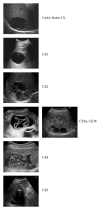Cystic echinococcosis in a single tertiary care center in Rome, Italy
- PMID: 24151631
- PMCID: PMC3789360
- DOI: 10.1155/2013/978146
Cystic echinococcosis in a single tertiary care center in Rome, Italy
Abstract
Background: Cystic echinococcosis (CE) is a chronic, clinically complex, and neglected disease. Its prevalence in Italy, a country of medium to high endemicity, remains poorly defined, as notification has long ceased to be mandatory.
Methods: We set up a retrospective cohort study involving all CE patients followed at our institute between January 2005 and December 2012. Demographical and clinical features were recorded and analyzed.
Results: CE was found in 28 patients (64.3%), mostly Italians from the central regions (50%), followed by subjects from the islands (33.3%) and Southern Italy (16.7%). Their median age was 45 years (IQR: 38.5-66.5), with Eastern Europeans being significantly younger (28 years, IQR: 19-39) than other patients (P ≤ 0.0001). A total of 149 cysts, mostly with hepatic localization (96%), were described. Based on the WHO classification, the cysts were mainly small (80.5%) and active (CE1 (73.8%); CE2 (7.4%)). Active cysts were more common in Eastern Europeans (85.7%) than Italians (66.7%).
Conclusion: Our data confirm CE occurrence in Italy. We emphasize the importance to have a national CE registry, opportunely recently introduced. This is essential to assess CE prevalence in this country, implement appropriate control measures, and improve patient management.
Figures


References
-
- Craig PS, McManus DP, Lightowlers MW, et al. Prevention and control of cystic echinococcosis. Lancet Infectious Diseases. 2007;7(6):385–394. - PubMed
-
- Gonlugur U, Ozcelik S, Gonlugur TE, et al. The retrospective annual surgical incidence of cystic echinococcosis in sivas, Turkey. Zoonoses and Public Health. 2009;56(5):209–214. - PubMed
-
- Jenkins DJ, Romig T, Thompson RCA. Emergence/re-emergence of Echinococcus spp.—a global update. International Journal for Parasitology. 2005;35(11-12):1205–1219. - PubMed
-
- Seimenis A. Overview of the epidemiological situation on echinococcosis in the Mediterranean region. Acta Tropica. 2003;85(2):191–195. - PubMed
Publication types
MeSH terms
LinkOut - more resources
Full Text Sources
Other Literature Sources

